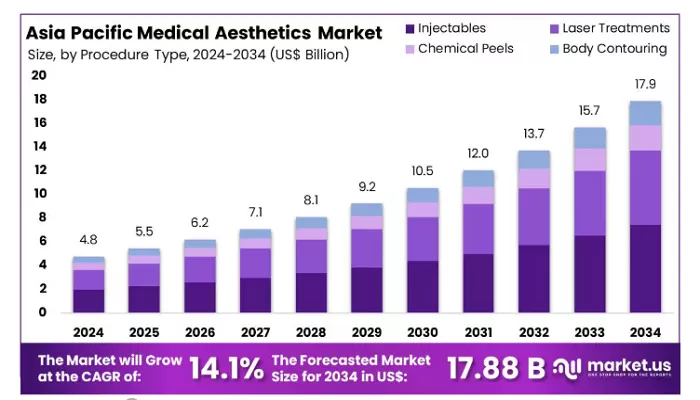The Asia Pacific medical aesthetics market is projected to grow from US$ 4.8 billion in 2024 to approximately US$ 17.9 billion by 2034, representing a robust compound annual growth rate (CAGR) of 14.1%, according to new industry forecasts.
Medical aesthetics refers to a broad range of non-surgical procedures aimed at enhancing physical appearance and improving self-esteem. These treatments address concerns such as aging skin, hair loss, and pigmentation disorders. With continued advancements in technology and rising consumer interest in non-invasive solutions, the sector is becoming increasingly integrated into both cosmetic and clinical healthcare systems.
In Thailand, one of the region’s rapidly growing markets, this surge is largely being driven by demographic changes. As of the end of 2021, roughly 18.5% of Thailand’s population—about 12.24 million people—were aged 60 or older. This aging population is fueling demand for services like anti-aging skincare and hair restoration, as more individuals seek effective ways to maintain youthful appearances.
The broader Asia Pacific region, including major players such as South Korea, Japan, and China, remains at the forefront of medical aesthetics due to its strong healthcare infrastructure and cultural emphasis on beauty. The popularity of procedures like dermal fillers, Botox, laser treatments, and chemical peels continues to rise, especially among consumers favoring minimally invasive alternatives to surgery.
Industry growth is also supported by rising disposable incomes, increased beauty consciousness, and medical tourism. The influx of international patients traveling for affordable and high-quality aesthetic treatments is bolstering revenues for clinics across the region.
However, the industry is not without challenges. The high cost of certain treatments, regulatory complexities, and safety concerns could pose barriers to growth. Even so, innovations in medical technology and a widening consumer base are expected to drive long-term market expansion.
As awareness of non-invasive aesthetic solutions grows, Asia Pacific’s medical aesthetics sector is not only reshaping regional beauty standards but also establishing itself as a key pillar of the global healthcare economy.
Related topics:


